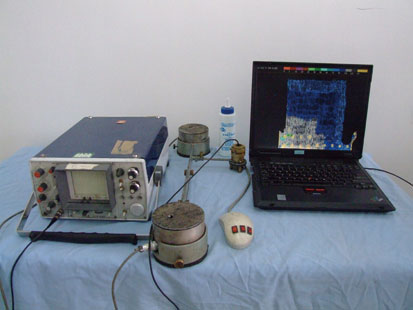5 Ultrasonic testing technology
Ultrasonic testing is one of the most important methods of non-destructive testing, including pulse reflection method, penetration method, reflector method, etc., each of which has its own characteristics, and can choose appropriate detection methods according to the different material structure.
Ultrasonic testing technology, especially ultrasonic C-scanning, has become a commonly used detection technology for large composite components such as aircraft parts due to its intuitive display and fast detection speed. Because large-scale ultrasound C-scan systems require water-jet coupling, and most of them are ultrasonic penetration methods, they can only be performed in large testing laboratories. The composite parts of the aircraft in use are mostly hollow structures, and the ultrasonic penetration method is powerless. Therefore, most of the ultrasonic testing of composite materials in the field is traditional artificial ultrasonic A-scan detection.
The artificial ultrasonic A-scan detection can cover all the detection surfaces of the structural parts point by point, and the device is simple and convenient to implement; the disadvantage is that the detection reliability is low, mainly depending on the technical level and professionalism of the detector.
6 ray detection technology
For composite structures, ray inspection is still one of the most direct and effective non-destructive testing techniques, especially suitable for detecting voids and inclusions in fiber reinforced laminate structures and for core deformation in sandwich structures. Detection of defects such as cracking, insufficient foaming of styrofoam, and abnormal position of the inlay. Radiation detection also has high detection sensitivity and reliability for cracks perpendicular to the surface of the material, but is insensitive to delamination defects in the composite structure. This method has been used as a means and specification for field testing by domestic and foreign military and a number of airlines.
New technology and new method for non-destructive testing of composite material external field
1 Portable ultrasonic C-scan system for external field detection

IUCS-II Portable Intelligent Ultrasound C Scanner
The IUCS-II portable intelligent ultrasonic C scanner was developed by the China Aircraft Strength Research Institute and is the only equipment developed in China that can be used for the detection of composite structures in field aircraft. The equipment is based on ultrasonic pulse reflection method, and the first generation product is developed by CTS-23A ultrasonic flaw detector as a platform, plus positioning system, special data acquisition and processing software notebook computer. An external vacuum chuck device detects composite materials such as façades and top surfaces. The ultrasonic probe adopts the self-developed focused water balloon probe, which has high detection resolution and can locate the layer where the damage is located. It can be used for the detection of planar, curved and assembled structural parts without water spray coupling. The pull-line large displacement sensor scanning positioning system can accurately locate defects at a probe movement speed of 800 mm/s. For different materials and structural forms, the echo distance mode and the echo amplitude mode can be imaged as needed, and the detection result is displayed in real time according to the display ratio of the actual size of 1:1. The second-generation upgrade product under development, based on the platform of industrial control computer and digital ultrasonic card, realizes high integration of digital ultrasound system and computer, realizes product digitization, reduces product volume, and is more convenient for field use.
Previous Next
Sculpture Artistic Port,Flower Port,Angel Frame
Cornice And Moldng,Other Ceiling Co., Ltd. , http://www.nsceiling.com
